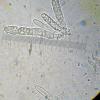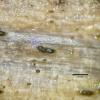
17-12-2025 18:35
 Michel Hairaud
Michel Hairaud
Bonjour à tous/Hi to everyone I am passing along

15-12-2025 15:48
 Danny Newman
Danny Newman
Melanospora cf. lagenaria on old, rotting, fallen

15-12-2025 15:54
 Johan Boonefaes
Johan Boonefaes
Unknown anamorph found on the ground in coastal sa

15-12-2025 21:11
 Hardware Tony
Hardware Tony
Small clavate hairs, negative croziers and IKI bb

15-12-2025 07:09
 Danny Newman
Danny Newman
indet. Rutstroemiaceae sp. on unk. fallen leavesMc

15-12-2025 07:05
 Danny Newman
Danny Newman
Pseudosclerococcum golindoi (det: Zotto)near Cosb

15-12-2025 11:49
 Danny Newman
Danny Newman
ITS sequences from the following two collections B

15-12-2025 12:34
 Danny Newman
Danny Newman
indet. Rhytismataceae on oak leafnear Purchase Roa
Like green hysterium?
Marja Pennanen,
09-05-2010 20:06
They are about 0,1-0,2 mm wide.
Marja Pennanen,
09-05-2010 20:09
Alain GARDIENNET,
09-05-2010 20:25
Re:Like green hysterium?
Bonsoir Marja,
Informations are lacking to give an opinion. Have you a description of the ascomata ? It doesn't look like an Hysterium.
We also need to know if the asci are unitunicate or bitunicate. There is apparently an ornementation on the spores, isn't it ?
Best regards,
Alain
Informations are lacking to give an opinion. Have you a description of the ascomata ? It doesn't look like an Hysterium.
We also need to know if the asci are unitunicate or bitunicate. There is apparently an ornementation on the spores, isn't it ?
Best regards,
Alain
Marja Pennanen,
09-05-2010 21:10
Re:Like green hysterium?
Hello,
I just checked another stem. The ascomata can be near 1 mm long and about 0.1 to 0,2 mm wide. It seems to open in the middle and turns darker when drying.
I put some in lugol and supprisingly found no asci, but one septate spores - maybe an anamorph - its looks the same, perhaps lighter.
So the real spores are 2-3 septate 13-16x4-6 and asci IKI- the longer with spores in one row, the shorter with spores in 2 rows.
I know its not a Hysterium, but the spores broght them to my mind ;)
I just checked another stem. The ascomata can be near 1 mm long and about 0.1 to 0,2 mm wide. It seems to open in the middle and turns darker when drying.
I put some in lugol and supprisingly found no asci, but one septate spores - maybe an anamorph - its looks the same, perhaps lighter.
So the real spores are 2-3 septate 13-16x4-6 and asci IKI- the longer with spores in one row, the shorter with spores in 2 rows.
I know its not a Hysterium, but the spores broght them to my mind ;)
Alain GARDIENNET,
09-05-2010 21:21
Re:Like green hysterium?
I've no idea, sorry.
Alain
Alain
Marja Pennanen,
09-05-2010 21:51
Re:Like green hysterium?
Ok,
thanks. Lets wait if somebody else has some ideas :)
The fungus itself isn't rare because I've found it in three places during the two last days. Its been very humid here and many, many tiny early spring things are at their best at the moment :)
Marja
thanks. Lets wait if somebody else has some ideas :)
The fungus itself isn't rare because I've found it in three places during the two last days. Its been very humid here and many, many tiny early spring things are at their best at the moment :)
Marja
Hans-Otto Baral,
09-05-2010 22:20

Re:Like green hysterium?
Dear Marja
I suspect that your specimen belongs in Exarmidium (Hyponectriaceae, Xylariomycetidae). I know E. inclusum, at least this was identified so, apparently by M. Barr. Two drawings are on the DVD, HB 6045 & 6226, perhaps as Massarina emergens or Tarbertia or Micraspis.
My E. inclusum was always on wood, and the spores were larger than yours: 15-20 x 6-8 µm.
The attached photos of more recent finds are on Rosa and Alnus from S-Sweden and the Alps.
I suspect that your specimen belongs in Exarmidium (Hyponectriaceae, Xylariomycetidae). I know E. inclusum, at least this was identified so, apparently by M. Barr. Two drawings are on the DVD, HB 6045 & 6226, perhaps as Massarina emergens or Tarbertia or Micraspis.
My E. inclusum was always on wood, and the spores were larger than yours: 15-20 x 6-8 µm.
The attached photos of more recent finds are on Rosa and Alnus from S-Sweden and the Alps.
Hans-Otto Baral,
09-05-2010 22:24

Re:Like green hysterium?
... but the ascomata vary between a small pore and a larger hymenial opening with dark teeth-like lobes. Also my two old drawings vary herein and in the paraphyses: Finds with small opening had simple paraphyses whereas one had apically swolen and anastomosing ones (6226 from Vosges).
Zotto
Zotto
Marja Pennanen,
10-05-2010 08:29
Re:Like green hysterium?
Thanks Zotto,
I'm pleased, that folks here do take my findings seriously enought to do so much work for them :)
The spores and way of growing seems alike.
These are narrower (something like Hysterium) and the habitat is on herbs, maybe some other Exarmidium...
I've got a tendency to find even these tiny ascomycetes too early, they may be still immature.
I'll try to look for them later and check weather something happens.
Marja
I'm pleased, that folks here do take my findings seriously enought to do so much work for them :)
The spores and way of growing seems alike.
These are narrower (something like Hysterium) and the habitat is on herbs, maybe some other Exarmidium...
I've got a tendency to find even these tiny ascomycetes too early, they may be still immature.
I'll try to look for them later and check weather something happens.
Marja
Robin Isaksson,
12-04-2024 12:46

Re : Like green hysterium?
I did also found this one on Epilobium today.
I have seen Exarmidium species before but none so greenish. and in key from 1986 the species shuld be brown or dark. My spores is 19-22 x 5-5.5um first aseptate later 3 septate, asci I - hymgel I- Interascal filaments absent.
best regards
I have seen Exarmidium species before but none so greenish. and in key from 1986 the species shuld be brown or dark. My spores is 19-22 x 5-5.5um first aseptate later 3 septate, asci I - hymgel I- Interascal filaments absent.
best regards










